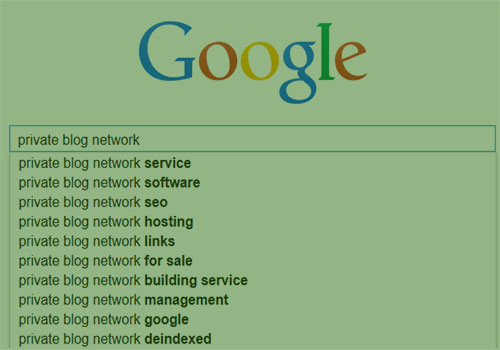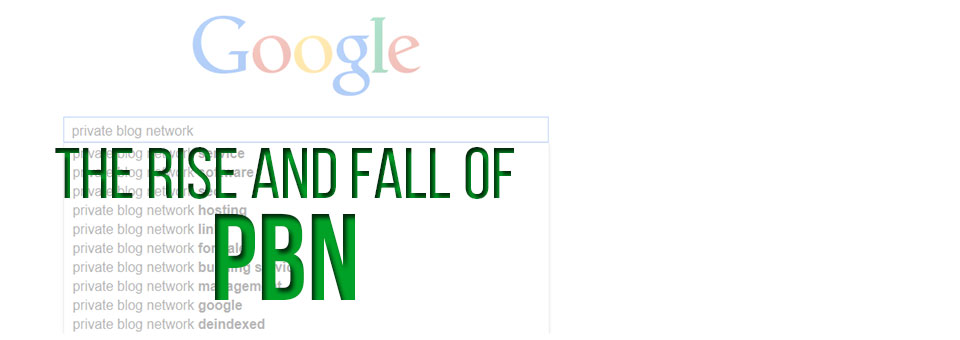If you haven’t been living under a rock for the past year or two you have certainly heard of PBNs or Private Blog Networks. In this post I’ll explain what PBNs are, how they function and why I’m not using one.

What Is A Private Blog Network?
Private Blog Network is a network of many smaller sites or blogs owned and controlled by a person or a company. PBNs are built with one simple goal: to create backlinks to a specific large website, also known as “money site” in the Internet marketing world.
You can build your own PBN or simply pay for services of an established PBN but more on that later.
Why Would You Use a PBN?
We all heard of SEO and we all know that Google prefers authority websites. The more authority your website has, the better rankings it’ll get in search engine results. Authority of a website is measured by considering many different factors, backlinks being one of the major factors. Simply put, if a lot of people are talking about you and a lot of other websites are linking to you then you’re considered as an authority.
For many years Google rankings were being manipulated simply because getting backlinks was easy and cheap. In many cases loads of backlinks could be free. In early 2007 a few hundred websites linked to George W. Bush’s page on White House website using the anchor text “miserable failure”. As a result, White House official website was the #1 results in Google’s search page for the phrase “miserable failure”. We can argue if George Bush was a miserable failure or not however we can all agree with a fact that one could rank a website on top of SERPs for a totally unrelated keyword phrase.
Google fixed this issue. At that point webmasters figured that they needed more links to reproduce the same results. Google fixed that too. Low quality backlinks from blog comments didn’t give much value so webmasters kept finding better backlinks and Google kept slapping these webmasters sooner or later.
Presently backlinks still matter a lot but Google became rather efficient at differentiating good and bad backlinks. This is where the idea of private blog network was born. You create websites, get them ranked and then use these websites to create “high quality” backlinks to your main site. The good element of this scheme is the fact that YOU are the one who controls all sites, content and links. People started using PBNs and saw great results in rankings and of course – income.
How To Build Your Own PBN
I must add a disclaimer here by saying that I have never built a PBN. I spent a lot of time considering it and I’ve spent even more time researching the architecture, costs, benefits and risk of such network. The more I looked into it the more complicated it seemed. A proper private blog network would take a lot of time, effort and most importantly money.
1. The most important aspect of a PBN is the privacy (hence the name). It has to be built in such way that no one (including google) would be able to figure out the relation between your PBN sites and your main site. You need to be extra careful and not leave any “footprints” online.
2. You need to buy high value domain names. Thousands of domain names are being flipped every single day and you would need to look out for a good domain to use for a PBN. A good domain must be aged (registered a few years ago), it must be “clean” as in not penalized by Google. If that domain has good backlinks to it – it’s a plus. If the domain is ranking well, even better. These domains usually cost from $20 to $100.
Alternatively you can use websites that list expired domains, which would normally cost under $20. Once again you’d need to do a fair share of research before buying one of the expired domains.
3. You will need to use private registration for all of the domains, which also costs money. Some people claim they use fake name and address for domain registration and although it’s against ICANN rules, it may also be illegal in certain cases. Besides the legal issues, using fake information to register a domain name is risky. If someone hacks into your account and steals your domain it will be impossible for you to get it back since you used fake information.
4. Hosting… this is where it gets tricky. Your PBN websites cannot be hosted on the same IP address. This means you cannot use them as add-on domains on your shared hosting, as all of the sites share the same IP. Your best bet would be purchasing a separate hosting plan for each website. In our time and age a basic shared hosting account costs about $5-$10 per month which isn’t much but it adds up.
5. So you’ve got your domain names and hosting. Now is the time to start installing WordPress (or whatever else you wish to you). Then you need to install plugins, select a theme, create ABOUT pages, privacy policy pages, etc.
6. A small PBN usually contains at least 20 websites in it. So you will have to repeat steps 1-5 many times over. Fed up yet?
7. Now the fun begins. You’ve set up all your websites, domains and hosting. At this point you’ll have to start creating good quality content for every website on your network. You can’t use spun content because it’s easily detectable and Google actually does “manual” site review where a real person reads your content. The content HAS to be good. Sure, you can outsource this task and pay $10+ per article and this is the price for mediocre articles. Don’t forget that your site needs to look legit so you’ll have to create at least 10 articles for each site.
8. Some would suggest that you’ll also need to build backlinks to these websites so they rank better, grow their authority which in return will give more authority to the outbound links that you would be putting into these sites.
Fed up yet?
So let’s summarize and try to calculate the cost of it all, of course we’ll go with a small PBN of only 20 websites.
Since we’re trying to make it as cheap as possible, we’re going to buy 20 expired domains at $12 each = $240. Add private registration at $2 each, that’s another $40. Hosting, 20 shared plans at $5 per month = $100 (or $1200 per year). 10 articles per site x 20 sites = 200 articles. It will take you a very long time to write 200 high quality articles, so you outsource half of it for a total of $1,000 (or more if you want better quality). So you just started and your first PBN is already costing you about $1,400 + a monthly recurring fee of $100.

Everything is set-up and you decide to add a backlinks from your PBN sites to your money site. A few days later you start seeing progress in SERPs and soon enough your money website is finally ranking on the first page of Google for your main keyword phrase. Success!.. assuming that your website is properly monetized.
The Downfall Of PBN
After spending thousand(s) of dollars for your very own private blog network you start reaping the rewards. However, one morning you wake up and realize that your traffic came to a halt. Your sales are at $0. You start nervously checking e-mails, internet marketing forums and you start feeling the anxiety slowly crawling closer and closer. What the hell happened?
Finally you log into your GWT account and see a nice little warning from Google. The warning would say that your site (sites) are been penalized by Google because of “thin” content or other practices. We call it “Google Slap”. Somehow Google figured out you were using a PBN (which is against their TOS) and they’ve shut you down. Goodbye early retirement. It sucks that Google controls a big chunk of our business but that’s the way it is and we need to adapt. There is no point in complaining and explaining that you spent $5,000 on your PBN, that you spent 10 hours a day for 150 days writing good content for your PBNs… they don’t care about any of it simply because you “broke the rules”.
Google has an enormous amount of tricks that we don’t know about and rest assured these tricks will be used to make Google a better place. Many of the very notorious Internet Marketers lost their rankings and earning overnight in the fall of 2014. Many of them are still trying to analyze what happened but they can’t figure out how Google managed to discover their PBNs. Some of these guys used separate hosting, whois privacy was on, content was unique, in one phrase they left no footprint. Yet, Google still managed to detect and penalize them.
I’ve been following Glen from ViperChill for quite a while and he was the first to report the PBN crackdown.
I was quick to announce on Facebook that only around 5% of our websites were ‘hit’ and deindexed by Google. That may seem small, but I admit it’s fairly substantial since we have almost 2,000 domains in our network.
This means that 100 websites from Glen’s PBN were hit. Not a very substantial number for his 2,000+ network. Glen also knows what he’s doing so I can’t even imagine the damage to smaller PBNs where the owners were probably less careful.
No Hat Digital also reported how they suffered a hit to their 600+ domains PBN:
Approximately 40% of our total network was hit, but the effects were not network-wide for us which is interesting. Looking at three segregated networks, one (about 60 sites) got entirely de-indexed, another lost only a handful of sites, one was not hit at all.
Many other websites followed with their numbers and their PBN horror stories.
I’ve seen many marketers cursing Google, cursing SEO and swearing to never waste another dollar (or minute) on PBNs. Some others (like Glen) decided on building even a bigger and stronger PBN and I don’t blame him. A proper PBN works well, when it works and as long as it works.
Is PBN Worth It?
I am not here to tell you what you should or shouldn’t do. However, I blog for the very purpose of being able to share my opinion.
I will not be building or using Private Blog Networks to rank my “money sites”. It takes a lot of effort, time and even more money to build one. I simply don’t have the time for it and I am not willing to spend $1,000+ on it. My biggest reason for not building a PBN is the risk of losing it all. I understand that big risk may result in huge rewards but I am not willing to take that risk.
One of my competitors has survived the PBN hit (I used OSE to checkout his links and his “private” blog network is not so private after all. However, for the past week or so he’s been steadily dropping down in rankings. Slowly but surely.
I used to chase every new shiny strategy for ranking, traffic, selling, etc. Then I’d usually get pissed off because something went wrong and all my efforts vanished overnight. This time I am in it for the long haul. I understand that concentrating on content won’t take me to the top of Google’s results by tomorrow but I am willing to keep working and waiting. Steady does it.

Should You use a PBN?
It’s up to you. Well executed PBNs seem to produce good results, however the risk of getting slapped by Google is always there. I can only speculate that another wave of PBN slapping is coming to the networks that survived (and to all of the newly created networks) but I don’t work for Google and I can’t predict the future (most of the time).
One last piece of advice on PBNs.
If you decide to “rent” someone else’s blog network or pay someone to backlink to your site from their PBN – perform your due diligence. When you own a PBN you’re the one who decides on all the outbound links and content. When you use someone else’s network, they might link to a whole bunch of different websites and this is bad. Google would be really quick figuring out there is something sketchy about 10 websites all linking to your weight loss blog, someone’s dog training course and someone else’s “how to make money blog”. There is also a high chance of content being spun or bad PLR and Google won’t take long to detect such content and ban those sites. Just be very very very careful if you decide to pay for PBN backlinks.
What are your feeling on PBNs? Comment below!
– Alex

